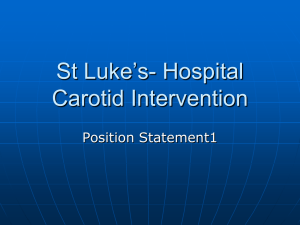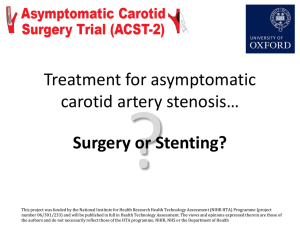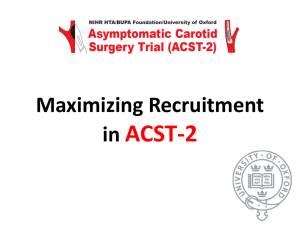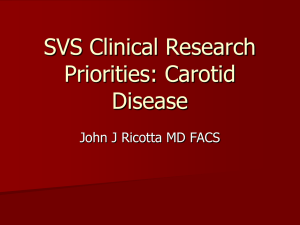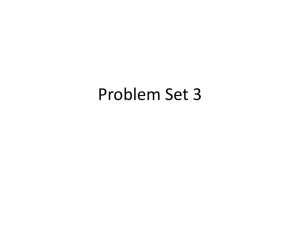Intensive Blood Glucose Contro and Vascular Outcomes in patients
advertisement
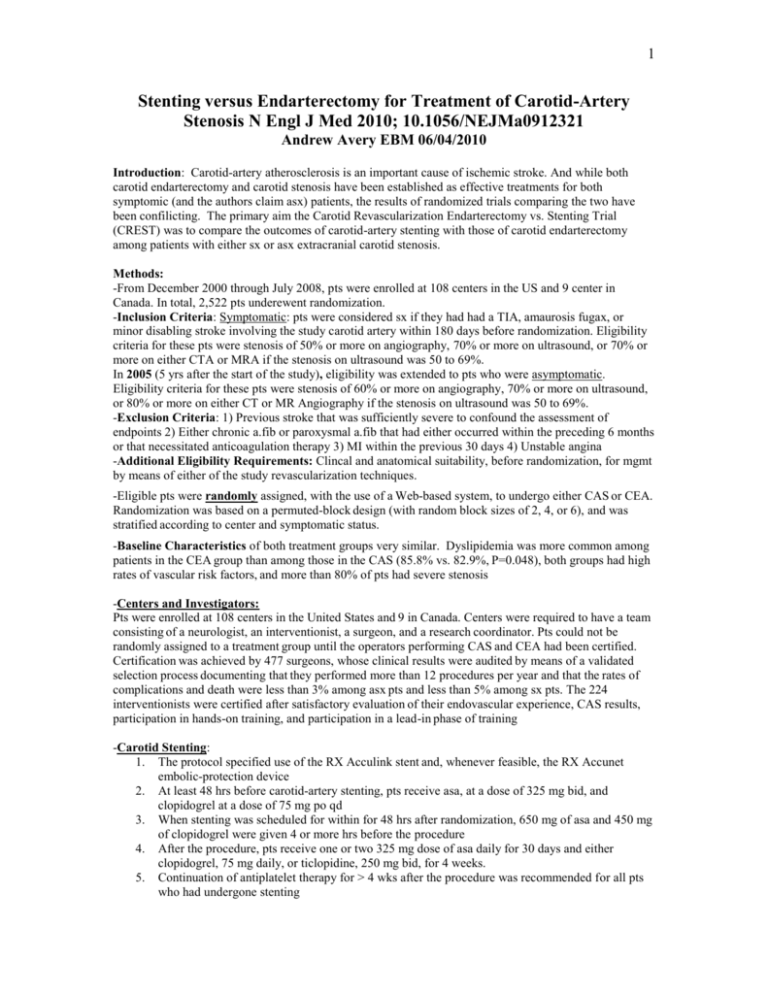
1 Stenting versus Endarterectomy for Treatment of Carotid-Artery Stenosis N Engl J Med 2010; 10.1056/NEJMa0912321 Andrew Avery EBM 06/04/2010 Introduction: Carotid-artery atherosclerosis is an important cause of ischemic stroke. And while both carotid endarterectomy and carotid stenosis have been established as effective treatments for both symptomic (and the authors claim asx) patients, the results of randomized trials comparing the two have been confilicting. The primary aim the Carotid Revascularization Endarterectomy vs. Stenting Trial (CREST) was to compare the outcomes of carotid-artery stenting with those of carotid endarterectomy among patients with either sx or asx extracranial carotid stenosis. Methods: -From December 2000 through July 2008, pts were enrolled at 108 centers in the US and 9 center in Canada. In total, 2,522 pts underewent randomization. -Inclusion Criteria: Symptomatic: pts were considered sx if they had had a TIA, amaurosis fugax, or minor disabling stroke involving the study carotid artery within 180 days before randomization. Eligibility criteria for these pts were stenosis of 50% or more on angiography, 70% or more on ultrasound, or 70% or more on either CTA or MRA if the stenosis on ultrasound was 50 to 69%. In 2005 (5 yrs after the start of the study), eligibility was extended to pts who were asymptomatic. Eligibility criteria for these pts were stenosis of 60% or more on angiography, 70% or more on ultrasound, or 80% or more on either CT or MR Angiography if the stenosis on ultrasound was 50 to 69%. -Exclusion Criteria: 1) Previous stroke that was sufficiently severe to confound the assessment of endpoints 2) Either chronic a.fib or paroxysmal a.fib that had either occurred within the preceding 6 months or that necessitated anticoagulation therapy 3) MI within the previous 30 days 4) Unstable angina -Additional Eligibility Requirements: Clincal and anatomical suitability, before randomization, for mgmt by means of either of the study revascularization techniques. -Eligible pts were randomly assigned, with the use of a Web-based system, to undergo either CAS or CEA. Randomization was based on a permuted-block design (with random block sizes of 2, 4, or 6), and was stratified according to center and symptomatic status. -Baseline Characteristics of both treatment groups very similar. Dyslipidemia was more common among patients in the CEA group than among those in the CAS (85.8% vs. 82.9%, P=0.048), both groups had high rates of vascular risk factors, and more than 80% of pts had severe stenosis -Centers and Investigators: Pts were enrolled at 108 centers in the United States and 9 in Canada. Centers were required to have a team consisting of a neurologist, an interventionist, a surgeon, and a research coordinator. Pts could not be randomly assigned to a treatment group until the operators performing CAS and CEA had been certified. Certification was achieved by 477 surgeons, whose clinical results were audited by means of a validated selection process documenting that they performed more than 12 procedures per year and that the rates of complications and death were less than 3% among asx pts and less than 5% among sx pts. The 224 interventionists were certified after satisfactory evaluation of their endovascular experience, CAS results, participation in hands-on training, and participation in a lead-in phase of training -Carotid Stenting: 1. The protocol specified use of the RX Acculink stent and, whenever feasible, the RX Accunet embolic-protection device 2. At least 48 hrs before carotid-artery stenting, pts receive asa, at a dose of 325 mg bid, and clopidogrel at a dose of 75 mg po qd 3. When stenting was scheduled for within for 48 hrs after randomization, 650 mg of asa and 450 mg of clopidogrel were given 4 or more hrs before the procedure 4. After the procedure, pts receive one or two 325 mg dose of asa daily for 30 days and either clopidogrel, 75 mg daily, or ticlopidine, 250 mg bid, for 4 weeks. 5. Continuation of antiplatelet therapy for > 4 wks after the procedure was recommended for all pts who had undergone stenting 2 -Carotid Endarterectomy: 1. At least 48 hours before carotid endarterectomy, patients received 325 mg of asa daily and continued to receive that dose for a year or more 2. Alternatives to this regimen were ticlodipine-250 mg po bid, clopidogrel-75 mg po daily, asa-81 mg po daily or asa and extended release dipyridamole-bid 3. -Follow-up Assessments of End Points: The primary end point was the composite of any stroke, MI, or death during the periprocedural period or ipsilateral stroke within 4 years after randomization 1. Neuro: Neurologic evaluation was performed at baseline and 18 to 54 hrs after the study procedure, 1 month afterward, and every 6 months thereafter. The evaluation consisted of the use of the National Institutes of Health (NIH) Stroke Scale (NIHSS), the modified Rankin scale, and the Transient Ischemic Attack (TIA)–Stroke Questionnaire 2. Cardiac: Cardiac BM levels were measure before study procedure and 6 to 8 hours after the procedure; EKG was performed before stenting or endarterectomy, as well as 6 to 48 hours and 1 month afterward; Carotid ultrasonography was performed before the study procedure; 1, 6, and 12 months afterward; and annually thereafter 3. General: A f/u phone interview, including administration of the TIA–Stroke Questionnaire, was conducted at 3 months and every 6 months thereafter. General health status was assessed at baseline, at 2 weeks,1 month after the procedure, and 1 year after randomization, with the use of the Medical Outcomes Study 36-Item Short-Form Health Survey (SF-36) -Stroke was defined as an acute neurologic event with focal symptoms and signs, lasting for 24 hours or more, that were consistent with focal cerebral ischemia. An adjudication process was initiated after a clinically significant neurologic event, any positive response on the TIA–Stroke Questionnaire, or an increase by 2 points or more in the NIHSS score. Stroke was defined as major stroke on the basis of clinical data or if the NIHSS score was 9 or higher 90 days after the procedure -MI was defined by a CK MB or troponin level that was 2x the upper limit of the normal range or higher according to the center's laboratory, in addition to either chest pain or symptoms consistent with ischemia or ECG evidence of ischemia, including new ST-segment depression or elevation of more than 1 mm in two or more contiguous leads according to the core laboratory Statistics: - Analyses were aimed at testing for superiority - The null hypothesis was that the two study treatments are equivalent; the alternative hypothesis was that the treatments differ - Designed to provide a statistical power of 90% to detect a hazard ratio for the primary end point of less than 0.54 or more than 1.49 with stenting as compared with endarterectomy - Intention-to-treat survival analysis was used - Multiple-imputation techniques were used to assess bias from differential rates of withdrawal from the study in the two groups - Secondary aims included estimating the modification of the treatment effect by symptomatic status, sex, and age, which were assessed through inclusion of the interaction terms in the proportional-hazards models Results: -Cheaters: One center was found to have fabricated some date. Data from this center (which had enrolled 9 patients undergoing carotid-artery stenting and 11 undergoing carotid endarterectomy) were excluded before any analyses were performed, resulting in a cohort of 2502 patients for all analyses Primary Endpoint: -There was no significant difference in the estimated 4-year rates of the primary end point between CAS and CEA (7.2% and 6.8%, respectively; hazard ratio for stenting, 1.11; 95% confidence interval [CI], 0.81 to 1.51; P=0.51) - During the periprocedural period, the incidence of the primary end point was similar with CAS and CEA (5.2 and 4.5%, respectively; hazard ratio for stenting, 1.18; 95% CI, 0.82 to 1.68; P=0.38), although the 3 rates of the individual end points differed between the stenting group and the endarterectomy group (death, 0.7% vs. 0.3%; P=0.18; stroke, 4.1% vs. 2.3%; P=0.01; myocardial infarction, 1.1% vs. 2.3%; P=0.03) - After the periprocedural period, the incidence of ipsilateral stroke was similarly low with CAS and with CEA (2.0% and 2.4%, respectively; P=0.85) Table 2. Primary End Point, Components of the Primary End Point, and Other Events, According to Treatment Group. Prespecified Secondary Analyses: -The periprocedural period rates of the primary end point did not differ significantly between the CAS group and the CEA group among symptomatic pts (6.7% vs. 5.4%; hazard ratio for stenting, 1.26; 95% CI, 0.81 to 1.96) or among asymptomatic patients (3.5% vs. 3.6%; hazard ratio, 1.02; 95% CI, 0.55 to 1.86) -An interaction between age and treatment efficacy was detected (P=0.02), with a crossover at an age of approximately 70 years; CAS tended to show greater efficacy at younger ages, and CEA at older ages - The prespecified analyses did not show a modification of the treatment effect by sex (P=0.34) 4 Table 3. Primary End Point and Its Individual Components among the 1181 Asymptomatic and the 1321 Symptomatic Pts, According to Treatment Group. A.) Kaplan–Meier curves for patients undergoing CAS and those undergoing CEA in whom the primary end point did not occur, according to year of follow-up. B.) Shows the hazard ratios for the primary end point, as calculated for the CAS group versus the CEA group, according to age at the time of the procedure. C.) Shows the numbers of pts in each group in whom the primary end point occurred during the study, according to age group. 5 Critical Appraisal: A. Are results valid a. Follow-up complete i. 69 pts lost to f/u in the CAS arm. 111 lost to f/u in the CEA arm. According to multiple-imputation analysis, still wouldn’t change statistics. b. Randomization i. Allocation of patients to either CAS or CEA was randomized c. Intention-to-Treat i. Yes d. Similar Baseline Characteristics i. Yes, although randomization negates the need for p values e. Blinding i. Study committees unaware of the treatment assignments adjudicated stroke and MI ii. Obviously pts and clinicians were not blinded to treatment group f. Equal Treatment i. Efforts were made to try and ensure that the pts in this multicenter study were treated similarly. All clinicians had to undergo the certification process as mentioned above, one stenting system was used and periprocedural medical therapy was similar. B. Summary: a. Composite Outcomes: Although the composite primary outcome of stroke, MI, or death did not differ significantly in the group undergoing CAS and the group undergoing CEA, there do appear to be significant differences in the number of periprocedural strokes, MIs and death. It would be useful, albeit difficult, to power this study for each of these endpoints individually. Secondly, although the composite outcomes were similar, the long-term morbidity from periprocedural strokes was found to have a much greater adverse affect on quality of life vs. periprocedural MIs. Raises the question of how severe the MIs were (?troponin leak with strain on ekg) when compared to CVAs. Should they really be considered equal in calculating a composite primary outcome? b. Improved Periprocedural Outcomes: The periprocedural outcomes in this study were the best ever reported in a randomized carotid revascularization study. Etiology is likely multifactorial: large number of cases performed at academic centers involved in study, utilization of the latest technology, credentialing of physicians. It is difficult to generalize results to less experienced centers. c. Addition of asx pts 5 years into the study: Added to further power study and authors claim that this does not affect the validity of the study. But in a study designed to compare CEA vs CAS in sx pts, does the addition of asx pts affect our ability to make that comparison? What question are we answering now, as it has not been established that either stenting or CEA is superior to medical mgmt for asx carotid stenosis. d. Medical mgmt: Speaking of medical mgmt, even the study authors admit that with the addition of asx pts, not studying the use of medical mgmt alone “sharply” limits the ability to generalize the results. e. So how will this effect my practice: As of now, I will still medically manage my pts with asx carotid stenosis. In sx pts, I prefer CEA vs CAS. However, in select symptomatic pts who are poor operative candidates, CAS appears to be a viable alternative. This is especially true in younger pts. who based on this study tolerate the procedure with fewer adverse side effects.


